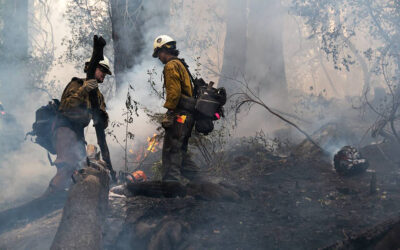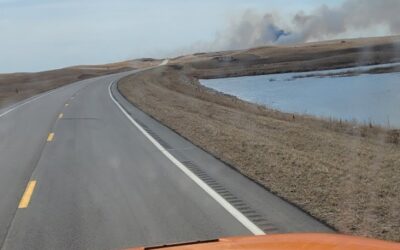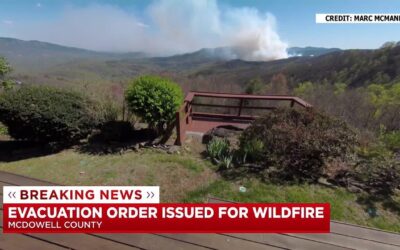The area has seen five massive wildfires since 2012

FILE – In this Aug. 14, 2015, file photo, a plane tries to help put out a wildfire burns near the Reynolds Creek area in the Owyhee Mountains, Idaho. Authorities have approved a plan to prevent giant rangeland wildfires in southwestern Idaho by clearing vegetation along 435 miles of roads to create fuel breaks. The U.S. Bureau of Land Management last week approved the work for the Idaho portion of the Tri-state Fuel Breaks Project that also includes fuel breaks in southeastern Oregon and northern Nevada. (Adam Eschbach/The Idaho Press-Tribune via AP, File)
By KEITH RIDLER Associated Press
BOISE, Idaho (AP) — Authorities have approved a plan to prevent giant rangeland wildfires in southwestern Idaho by clearing vegetation along 435 miles (700 kilometers) of roads to create fuel breaks.
The U.S. Bureau of Land Management approved the work for the Idaho portion of the Tri-state Fuel Breaks Project that also includes breaks in southeastern Oregon and northern Nevada.
The area contains sagebrush steppe that is key habitat for sage grouse and other wildlife on land also used by cattle ranchers and outdoor enthusiasts.
The agency opted to issue separate decisions for work in Idaho and Oregon on fuel breaks that will be tied into an existing fuel break system in northern Nevada. It’s not clear when the agency will issue a decision on proposed fuel breaks in Oregon. The Idaho decision was issued last week.
The Oregon and Idaho area to be protected includes up to 5,600 square miles (14,500 square kilometers).
The Idaho fuel breaks protect 2,500 square miles (6,500 square kilometers) by creating 200-foot (60-meter) buffers on each side of roads. That adds up to about 32 square miles of cleared vegetation in Idaho.
The two-phase plan is to put in fuel breaks on more heavily traveled Idaho routes and follow that up with breaks on interior routes, giving the area a jigsaw puzzle appearance. In theory, one piece of the puzzle might burn, but the fuel breaks would aid firefighters in preventing an adjacent piece from catching fire.
“This project will give our wildland firefighters a critical tool, enabling them to fight wildfires strategically and contain them much more quickly,” William Perry Pendley, the bureau’s deputy director for policy and programs, said in a statement.
The area has seen five massive wildfires since 2012, ranging from 365 square miles (950 square kilometers) to 870 square miles (2,250 square kilometers).
Sagebrush ecosystems are poorly adapted to such wildfires, the agency said, with fires occurring only once every few hundred years. However, the area has been invaded by invasive and fire-prone cheatgrass that relies on wildfire and burns about every five years.
After a wildfire, cheatgrass and other invasive plants such as medusahead rye outcompete native plants, “converting burned sagebrush landscapes to annual grass ecosystems that can no longer support their historic biodiversity,” the agency said in its decision.
Ranchers in the area generally support the fuel breaks.
Conservation groups say the fuel breaks themselves could become avenues for the spread of invasive species and will also fragment ecosystems and isolate wildlife populations, including sage grouse, that will no venture into the open ground of the fuel breaks.
Fuel breaks “don’t work,” said Talasi Brooks, an attorney with Western Watersheds Project. Secondly, “they are typically not maintained by BLM, and as a result they just become a huge weed vector.”
She said the group was looking into legal options.
The Idaho Department of Fish and Game said sage grouse numbers in the state have dropped more than 50% since 2015. In Oregon, bird numbers last year reached their lowest number — 14,000 — since reliable estimates have been recorded beginning in 1996, according to the Oregon Department of Fish and Wildlife.
Sage grouse are a ground-dwelling, chicken-sized bird with an elaborate mating ritual. Its population has declined in recent decades and the birds have been considered for protection under the Endangered Species Act. Such a listing could limit human activities in the bird’s habitat.
All contents © copyright 2020 The Associated Press. All rights reserved.




